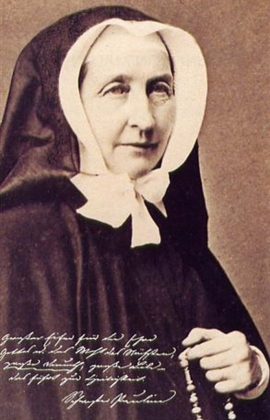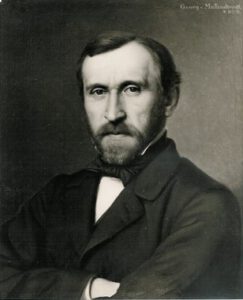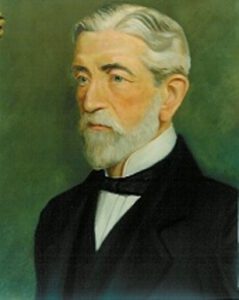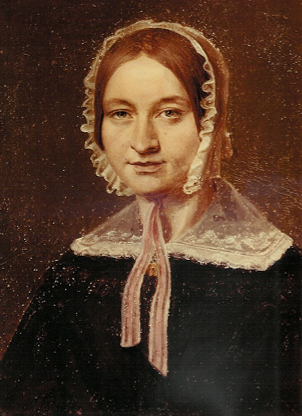"She saw with her heart, she saw with the eyes of Jesus."
Cardenal Ratzinger
"Because Mother Pauline was a believer, she was therefore a visionary: she saw with her heart, she saw with the eyes of Jesus, and therefore she saw well. The faith of our Blessed was not only an act of intellectual obedience, a Yes to the articles of the Creed; her faith was a way of life, in communion with the life of Jesus, thus participating in the life of the true vine-she saw well and lived well." From the Homily of the then Cardinal Joseph Ratzinger, now His Holiness Benedict XVI, on the occasion of the Beatification of Mother Pauline, in the Parish of the Canadian Martyrs. Rome, April 1985.

"Mother Pauline is an example for our life. For the fearful unrest of modern people, she shows a path to inner peace: to confidently and courageously seek God in the suffering brother and sister. So is her message current, as the search for God is always current." From the homily of Pope John Paul II, Beatification Mass, April 1985.
Her Life


Pauline von Mallinckrodt was born on June 3, 1817 in Minden, Westphalia. She was the oldest daughter to Detmar von Mallinckrodt – a Protestant who held a high position in the Prussian Government – and his wife, Baroness Bernardina von Hartmann, who was a Catholic and born in Paderborn. Since her early childhood, Pauline enthusiastically learnt the Christian principles taught by her mother with love. From her mother, she inherited a profound faith and a great love for God and for the poor and a strong commitment to the Catholic Church and its shepherds. From her father, she received determination, genuine principles, respect for other people and the duty to honor the promises made. Pauline was encouragingly inspired by one of her greatest educators, Luisa Hensel, her religion professor, but also by the priest Anton Claessen, and later, by the Cologne Auxiliary Bishop.
Serving others
Pauline spent part of her childhood and youth in Aachen, where her father had been transferred. Due to her mother’s death, Pauline, then just 17 years old, took care of the household and of her two younger brothers, George and Hermann, and her little sister Bertha. Pauline tried to fulfill her father’s every wish, but nonetheless, she still found time to help poor and sick persons. In Aachen, with her friends and using the means at her disposal, she called on and supported needy people who, owing to the century’s technical, economic and social challenges, were in material and spiritual need.
“Mother Pauline knew purifying sufferings early in her youth which matured her faith rapidly: her parents’ mixed matrimony; the death of her mother; her assumption of the role of mother when she was 17. All these events laid the foundations for her responsibility as future foundress of a new family of Christian charity. The Lord prunes the vine shoots that bear fruit,” expressed the then Cardinal Joseph Ratzinger in 1985.
At 18 years old, she received the sacrament of Confirmation and started attending daily Holy Mass. Sometime later, at a time when daily reception of the Eucharist was not the norm, Pauline sought and received permission for daily Holy Communion. The sacrament of Confirmation was the spark that inspired Pauline to consecrate her life to God.



After her father retired and moved to Paderborn, Pauline continued working for the needy. She invited and enthused other ladies and young to alleviate the conditions of sick and poor; drawing her attention to the education and instruction of poor children. She found a kindergarten and received blind children to protect them and instruct them. Enlightened by the grace force, she organized the Feminine League to care for the sick and poor. The kindergarten she found in 1840 was Pauline’s unique and novel idea of providing safekeeping and a nurturing environment for these neglected children
Pauline’s intense activity within the Catholic Church could have been a reason for dispute between she and her father, who worked in a Protestant government. However, as a he was a noble gentleman and was convinced that the State should not interfere with religious matters, he made a secret pact with her daughter on behalf of the fairness and justice principles both of them support, and never got in the way of Pauline’s work. Therefore, Mr. von Mallinckrodt was not promoted. Pauline’s brothers George and Hermann followed their father’s example on the defense of the rights and liberties of the Catholic Church.

An outstanding girl
“It seems as though grace draws a circle around her favorites, within which they feel comfortable with the eternal and are not averse to the divine. Words count little; example and personal presence, everything. Life and its deeds are a more powerful light than words.” These words were written by Professor Christopher Schlueter in his diary in 1840 after his first acquaintance with Pauline von Mallinckrodt, who was then visiting her relatives in Muenster. A group of theologians and literary scholars met regularly in the home of the almost-blind professor. He admired Pauline’s dynamic spirit, but above all, her intense piety. “Pauline receives communion daily and on the other hand participates joyfully in the things of the world. Wherever and whenever she can, she creeps into the huts of the poor to alleviate their suffering. She gives alms, consoles, advises and prays for the sick, shuns neither dirt nor vermin, but with a smile offers everyone the same comfort. A more charming and attractive image of ‘living-in-God’ can scarcely be imagined,” he wrote in a letter to Pauline’s cousin, Bertha von Hartmann.
Foundation of the Congregation
In 1842, shortly after the death of her father, Pauline was entrusted with a few poor blind children. She cared for them, with unfathomable tenderness. And since God has a plan for every one of us, blind children were the ones who brought the Congregation into being. Pauline sought admission to several religious congregations, but none of them would care for the blind. She thus sought advice from Monsignor Anton Gottfried Claessen, who, after attentively listening to her and praying for her, showed her that she had been called by God to found a Congregation. Once the approval had been obtained by the Bishop of Paderborn, Monsignor Francis Drepper, Pauline and three other women joined together as the first Sisters of Christian Charity, also known as Daughters of the Blessed Virgin Mary of the Immaculate Conception, on August 21, 1849. Soon, they opened schools and houses for children.
Exile from Germany
Blessed by the Church, the Congregation attained great success and rapidly grew in Germany; however, as with any work done for God’s greater glory, it had to overcome suffering and was soon put on trial. During Otto von Bismarck’s rise to power, a tough persecution was initiated against the Catholic Church in 1871 known as the Kulturkampf. Mother Pauline was overwhelmed by the closing and seizure of all the houses of the Congregation in Germany. Thanks to her profound faith, Mother Pauline saw God’s hand in this religious persecution. Her words to the Sisters were, “The Lord gives and takes away; blessed be the name of the Lord.” Firmly convinced that she was protected by God and surrendering to his Providence, she started looking for new apostolic fields. She bought a house in Belgium, where the Bishop of Paderborn, Monsignor Conrad Martín, was sheltered from the persecution of the Kulturkampf.
“The Lord prunes the vines that yield fruit. This word became a concrete experience with the huge political struggle for the rights and self-government of the Catholic Church, carried out in Prussia. The houses of the newly created congregation were seized, the Sisters were expelled, the foundation seemed to be near the end. Indeed, nonetheless, it did yield its fruits as it expanded to the United States and Latin America. Pruned by the Lord, this House grew into its prime of life,” expressed Cardinal Ratzinger, highlighting Pauline’s strength over adversity and persecution.


The Congregation arrives in America
At the same time of the persecutions in Germany, requests from North and South America for Sisters to teach the German immigrant children came pouring in. Pauline responded by sending a small group of Sisters to New Orleans in 1873. Within a few months Pauline sent more Sisters to the United States, and she herself made two extensive trips to the New World so as to witness firsthand the needs of the people in both North and South America. Within a short time after, a provincial motherhouse and novitiate were established in Wilkes Barre, Pennsylvania. From then on, the Sisters opened houses in the archdioceses of Baltimore, Chicago, Cincinnati, New York, Philadelphia, St. Louis, and St. Paul, and in the dioceses of Albany, Belleville, Brooklyn, Detroit, Harrisburg, Newark, Sioux City and Syracuse. In November 1874, the first Sisters arrived in the Diocese of Ancud, Chile, requested by Monsignor Francisco de Paula Solar. A few years later, they would be leaving for Río de la Plata, in 1883 to Montevideo, Uruguay, and in 1905 to Buenos Aires, Argentina.
Returning home
By the end of the 1870s the religious persecution in Germany had ended and the exiled Sisters in Belgium were able to return to their homeland and continue their work. The community had grown in number and in missions during the time of oppression: there were nine houses in Europe, twenty-seven in the United States, and eight in Chile. Mother Pauline returned to Paderborn after her second trip to North and South America in 1880. Within a few months, to the great sorrow of the Sisters, Pauline became ill with pneumonia and died on April 30, 1881.
